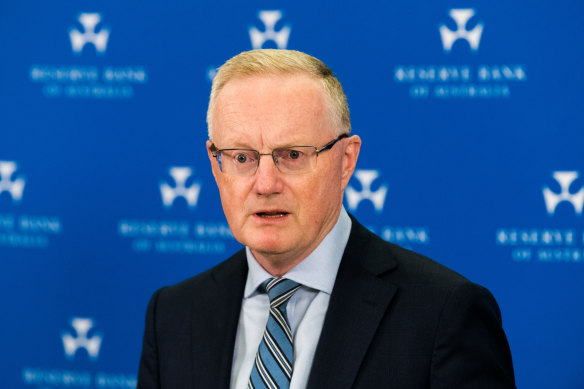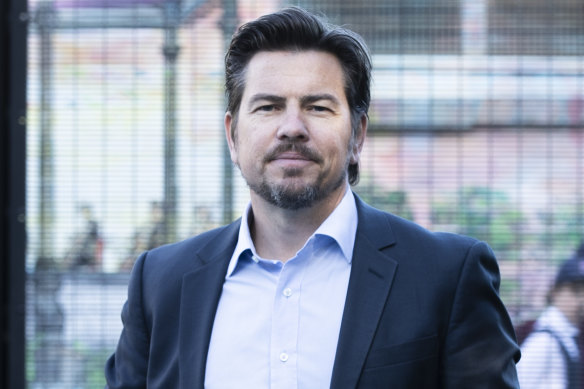This was published 1 year ago
Recession risk as RBA weighs inflation-busting interest rate rise
By Shane Wright
The Reserve Bank could drive the economy into a recession if it delivers another interest rate rise this week, with warnings that cash-pressed renters and home buyers are already on the brink of extreme financial pain.
The bank board, which has taken official interest rates from 0.1 per cent to 4.1 per cent since May last year in the most aggressive tightening of monetary policy since the 1980s, meets on Tuesday with economists split on calling if the RBA will lift rates another quarter of a percentage point.

RBA governor Philip Lowe will head his penultimate meeting of the bank board on Tuesday. He is being warned another cash rate rise would risk a domestic recession.Credit: James Brickwood
Financial markets, which have been more accurate than economists on rate movements since the RBA started normalising monetary policy, put the chance of an interest rate rise at less than one-in-10.
AMP chief economist Shane Oliver said the most recent inflation data, which showed the inflation rate easing to a lower-than-expected 6 per cent, and retail sales slipping 0.8 per cent in June, suggested the RBA should hold the cash rate steady.
He said more tightening, on top of the previous rate rises which are yet to filter through the economy, would sharply increase the risk of a recession.
“The RBA is now getting what it wanted on inflation and the ongoing weakness in real retail sales highlights the high and increasing risk that it will knock the economy unnecessarily into recession if it keeps tightening,” he said.
“That said, it is a close call and given the RBA’s concerns about services inflation and wages it wouldn’t be a surprise to see the RBA hike by another 0.25 per cent.”
The economy has already slowed under the weight of high inflation and the Reserve Bank’s official interest rate increases. GDP increased just 0.2 per cent in the March quarter while GDP per person contracted.
Last week’s inflation data shows rents growing at 6.7 per cent over the past year, their fastest pace since 2009. Monthly repayments on an average $600,000 mortgage have soared by more than $1350 since May last year while about 800,000 borrowers with fixed-rate loans – set when interest rates were at record lows – are expected to transition into much more expensive loans through 2023.
Despite the slowdown in economic activity, unemployment has remained at near 50-year lows. Yet, there are signs the hot jobs market is cooling, with vacancies falling and total jobs created per month slowing.
A key concern for the RBA has been inflation across the services sector of the economy where the price of labour is a key cost driver. The most recent consumer price index shows prices for services up by 6.3 per cent over the past 12 months.
But the peak in services inflation occurred late last year. Services inflation peaked at 2.1 per cent in the December quarter, before easing to 1.7 per cent in the March quarter and 0.8 per cent in the just completed June quarter.
KPMG chief economist Brendan Rynne said while there were arguments for an interest rate increase, the case for the RBA to pause was stronger.
He said the most recent inflation figures should give the bank encouragement that it was bringing price pressures under control, cautioning another rate risk could be damaging to the economy.
“A pause allows the RBA more time to gauge the lagged effect of interest rate changes on unemployment and reduce the risks of overshooting,” he said.

HSBC Australia chief economist Paul Bloxham believes the RBA will increase interest rates once more.Credit: Louie Douvis
But HSBC Australia chief economist and former RBA economist Paul Bloxham said with inflation still above the Reserve’s 2-3 per cent target and a tight jobs market, at least one more rate rise was likely.
“On balance, we see the RBA as near the end of its hiking phase, but likely to deliver one more hike which we expect in August,” he said.
This week’s board meeting is the second last to be headed by Governor Philip Lowe. His successor, deputy governor Michele Bullock, will become the country’s first female central bank governor from September 18.
The Reserve Bank will this week update its forecasts for the economy. In its May update, the bank forecast inflation to be at 6.3 per cent at the end of June and economic growth to be slowing due to a drop-off in household consumption.
Those forecasts were predicated on the cash rate reaching a peak of 3.75 per cent. Instead, the cash rate has been at 4.1 per cent since early June.
St George Bank economists estimate that real per person spending fell in both the December and March quarters, and last week’s poor retail trade figures suggest this had continued into the June quarter.
Real per capita consumption contracted over the December and March quarters. The retail spending data, which accounts for around a third of household consumption, suggests the contraction likely extended to the June quarter.
Cut through the noise of federal politics with news, views and expert analysis. Subscribers can sign up to our weekly Inside Politics newsletter here.